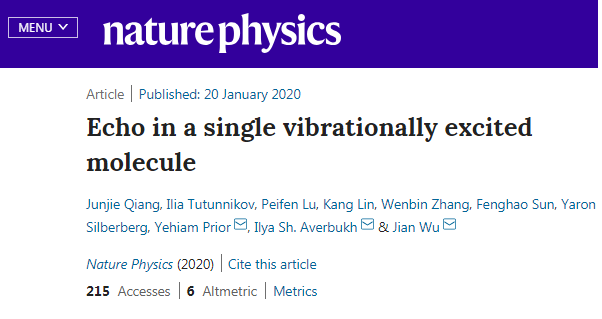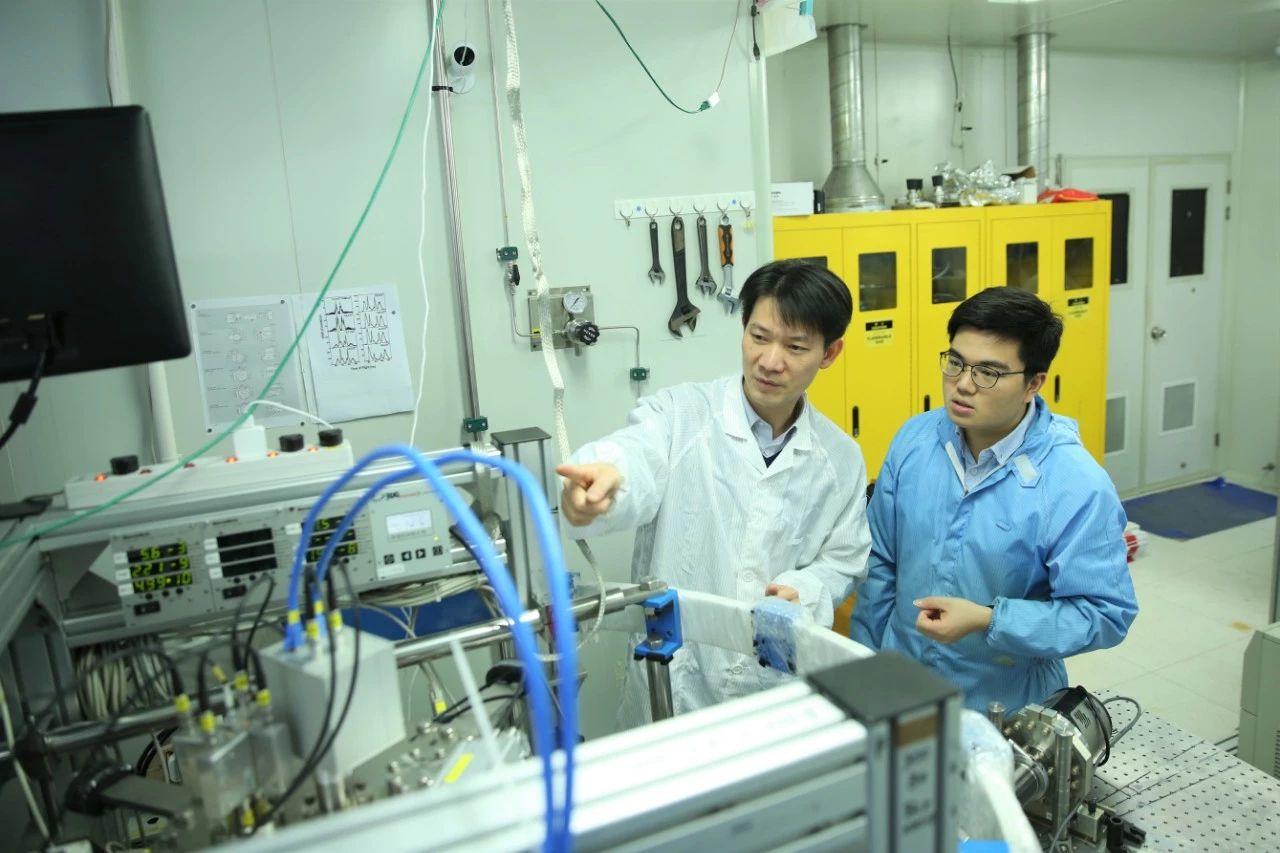
Researchers from East China Normal University (ECNU) in China and Weizman Institute of Science in Israel have made a breakthrough in the measurement and control of ultrafast dynamics of molecules in strong laser fields. They experimentally observed the echo of a vibrational wave packet in an isolated single molecule for the first time. The article “Echo in a single vibrationally excited molecule”, which introduced the observation, was published in Nature Physics on January 20.

This work is a cooperation between the group of professor Wu Jian from ECNU and the group of professors Yehiam Prior and Ilya Sh. Averbukh from Weizman Institute of Science.Prof. Wu Jian’s PhD student Qiang Junjie and Ilia Tutunnikov, a PhD student from Weizman Institute of Science, are the first authors of the article.

Prof. Wu Jian (left) and his PhD student Qiang Junjie in the lab.
The echo of the acoustic wave is a typically observed natural phenomenon. When the acoustic wave meets an obstacle, the reflection results in an echo during the propagation. A coherent response was studied when an ensemble of nonlinear objects — e.g., spins, molecules, plasma, or a beam of particles—were acted on by an external stimulus. Because each of the nonlinear objects evolves at a different frequency, the response disappears as the members of the ensemble step out of the phase. However, by applying a second pulsed excitation, and then waiting for a time period equal to the delay between the two excitations, it is possible to retrieve the initial coherent response — the echo. Echoes are generally used to examine the quantum coherence of the system as well as to enable the observation of inherent properties within an object. Echoes also play an important role in numerous applications. For instance, the electron spin echoes applied through magnetic resonance imaging.
From left to right: Qiang Junjie, Ilia Tutunnikov, Yehiam Prior, Wu Jian and Ilya SH. Averbuk
Although in most cases the echoes were accepted as a collective response of inhomogeneous ensembles, researchers for the first time were able to observe the echo of a vibrational wave packet in an isolated single molecule.

Figures (a)-(c), Building-up of the vibrational wave packet of argon dimer molecule. In the time domain, a structure similar to that of the double-slit single electron (photon) diffraction experiment was observed.
The 'single particle experiment' is an experiment based on the interference of a single electron, or single photon, when it passes through a double slit —one at a time. The probability of hitting the screen at a specific location is due to quantum mechanics in which it derives from repeating the measurement many times, each time with a new single particle and distribution. These experiments are known as ‘single particle’ experiments, and this is exactly the type of experiment of the echo in a single molecule, but in the present case the interference happens in the same time domain: the molecules interact with the laser fields one at a time and are individually measured. As in similar experiments, to see the distributions, the measurement is repeated many times and then driven by an ultrashort femtosecond (10-15s) laser pulse; thus, a vibrational wave packet in an argon dimer cation is launched. This vibrational wave packet oscillates back and forth before it disperses swiftly. After a time delay of T, a second laser pulse is applied. It is then demonstrated that an impulsive molecular response— the echo — does emerge at the instant of 2T.
This experiment was conducted by a group of ECNU researchers who employed two femtosecond laser pulses to excite a vibration wave packet echo in an isolated molecule. The spatiotemporal dynamics of the echo were visualized by scanning the time in delay of a probe pulse by dissociating the molecule. Two mechanisms were identified for the observed echoes — i.e., the potential shaking of the a.c. stark-induced molecule and the creation of a depletion-induced ‘hole’ in the nuclear spatial distribution. The semiclassical and the full-quantum simulations by the group at Weizmann Institute of Science successfully reproduced the experimental observation and confirmed the mechanisms of the whole process.

Figures (a)-(c), Building-up of the vibrational wave packet of argon dimer molecule. In the time domain, a structure similar to that of the double-slit single electron (photon) diffraction experiment was observed.
ECNU’s Professor Wu Jian led the group in their focus on the precision measurement and control of the ultrafast dynamics of molecules in strong laser fields. In collaboration with the groups from Israel and France, Prof. Wu’s group have made several breakthroughs on the topic of molecular echoes since 2016. For example, the first spatiotemporal visualization of the rotational echoes (Phys. Rev. X 6, 041056) was selected as a “Research Highlights” inNature Photonics.11. 27 (2017) and also reported as a “World News of Molecular Photonics” in Laser Focus World (published in April, 2017). Not too long ago the echoes were used to probe the collisional dynamics of dense gas mediums subdued by high pressures (Phys. Rev. Lett. 122, 193401) and to observe collisions beyond the limits of secular approximation (Nature Communications 10, 5780).
Click to read the full article here: